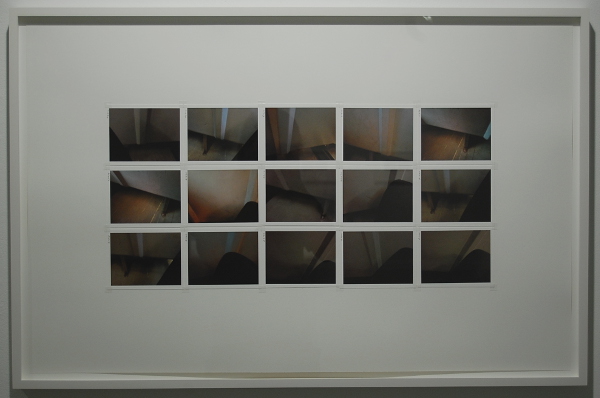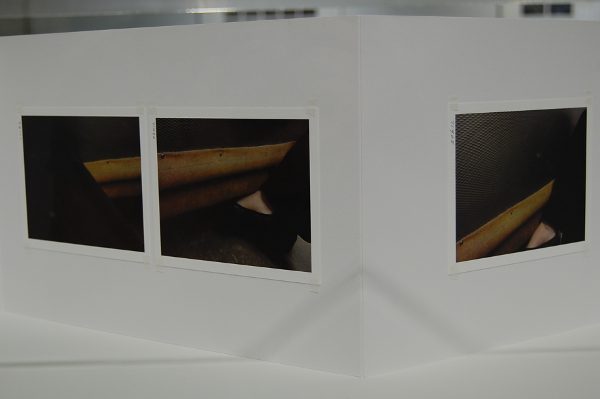
Ditta Baron Hoeber’s cell phone studies at Moore
In the Goldie Paley Gallery at Moore College of Art & Design, Philadelphia-based artist Ditta Baron Hoeber presents her recent work in the solo exhibit “Proximity,” curated by Kaytie Johnson. While spending time in transit riding trains, Hoeber began a series of cell phone photographs capturing various components of her surroundings. The result is a large body of abstract, dusky and often rough images that reveal more about process and the passing of time than the objects on the other end of the lens.
The large gallery space is lined on all sides with shadowy images of industrial-looking fixtures and plays of light on metal, plastic and fabric surfaces. At the center of the room, two tables display additional photos on accordion-like mats. Many of the images are deceptively similar to each other, especially when they appear in series, and this similitude makes for a challenging show.
Ditta Baron Hoeber, “Blue Train.”
As physical prints in succession, these photos call to mind celluloid film stills. There is certainly no mistaking the sequence of rectangular shots in a film strip, and Hoeber’s photographic process verges on non-narrative cinema as much as it does abstract photography. On the topic of narratives, Hoeber defies the documentary and storytelling uses of cameras in favor of providing mystery and ambiguity. This effect is simultaneously refreshing and jarring. While it may take some time to acquaint oneself with these indistinct frames, once an entry point is found the struggle gives way to a wash of possibilities, limited only by the imagination.
Through embracing the low-quality, gritty representations produced by some phones, Hoeber captures an aesthetic that is both proliferating and retreating into history. The ubiquity of phone cameras has begun to eclipse the need for point-and-shoot digital versions, and their quality is steadily increasing, providing both more and better integrated photographic possibilities into our pockets. Forgetting one’s camera at home is much easier than forgetting one’s phone, which these days provides many more services than merely voice communication. How strange that we still call them ‘phones’…
Ditta Baron Hoeber, “Black Slipper.”
While quality improves, the digital artifacts and poor resolution of flip phone apertures will in many ways be lost to technological advancement. Technophiles and Facebook bar-photo junkies may welcome this change (for good reason) but it also marks a unique aesthetic shift that we many never see again. At a time when VHS, vinyl records, and analog instruments are making a comeback due to their specific and hard-to-reproduce qualities, Hoeber manages to harness this medium before its inevitable death knell.
If there is any subject to Hoeber’s work here, it would have to be the minute and the idiosyncratic. We see the runners of public transportation floors, the texture of shirts, splashes of dim, orange light and the humble screws and bolts that hold our everyday world together.
Although it would seem that words could be cumbersome here, Hoeber will be reading some of her poetry amidst these images on June 20 at 6 p.m. in the gallery. The pictures and poetry, however, are not representative of one another and will exist, as the title presupposes, only in proximity. It will be peculiar to see how words pan out alongside the ostensibly wordless. The show runs through August 31.
Moore College of Art & Design is located at 20th Street and the Benjamin Franklin Parkway, Philadelphia; [email protected]; thegalleriesatmoore.org.
Recent Content
-
Artsarticle ·
-
Artsarticle ·
-
Artsarticle ·



